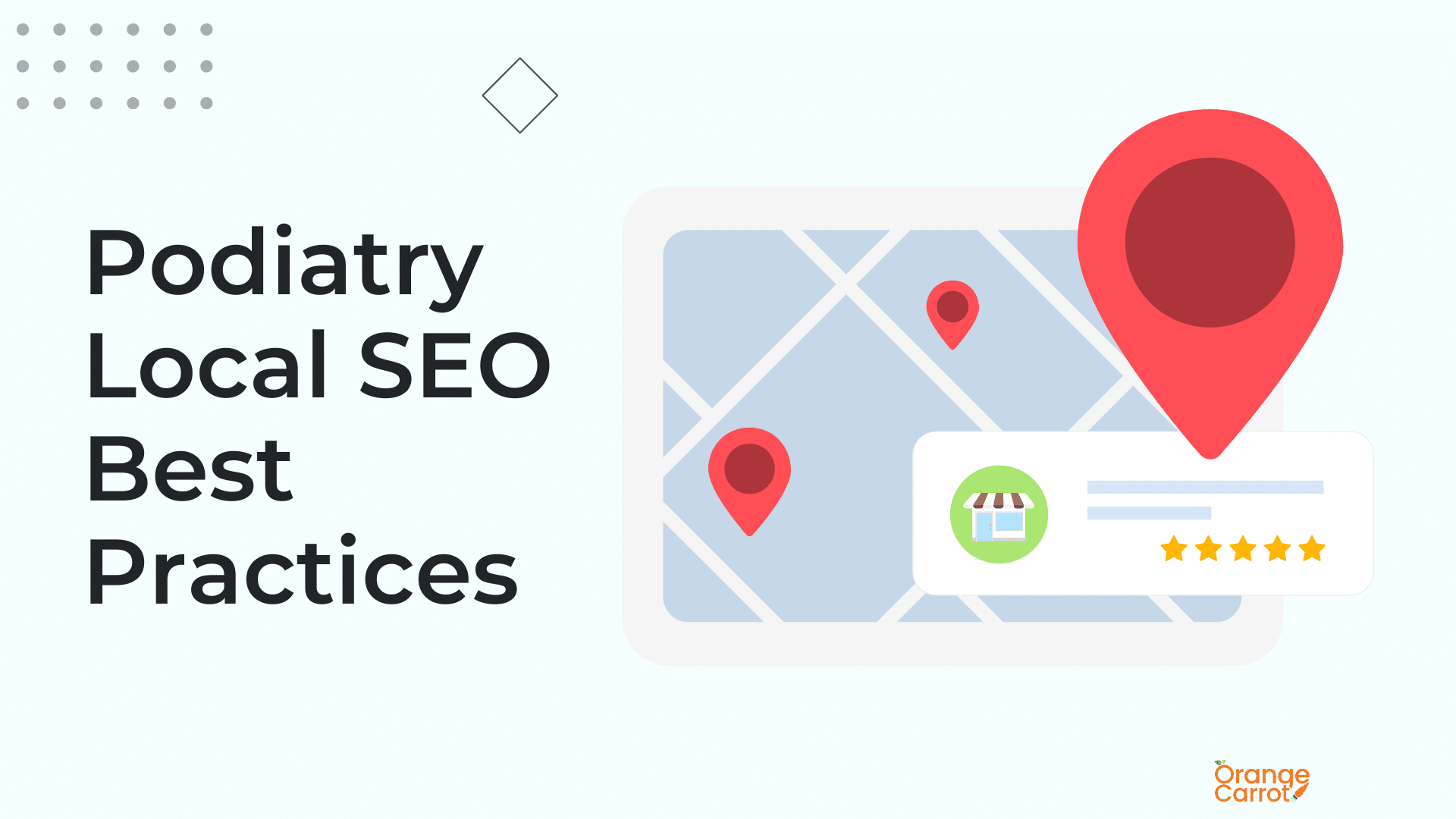
After picking through analytics and listing data for more than 50 foot-and-ankle clinics, one truth keeps shouting back: local visibility has less to do with “secret sauce” hacks and more to do with basic maintenance.
When a clinic’s address is wrong on even a single major directory, almost two-thirds of potential patients say they’ll move on to the next provider. And the fact that 42% of local searchers tap a Map-Pack result and never scroll further, you can see why small slip-ups lead to empty appointment slots.
Let’s look at some of the most impactful, tried and tested local SEO strategies for podiatrists.
Fix these three areas and the ranking needle usually starts twitching within a single billing cycle; no fancy tricks required.
“Chiropodist” should stay locked in as your primary category because Google’s algorithm gives that slot the most weight. It is strange because Chiropodist is actually a British word; not used in the USA. Google hasn’t switched that part yet for Americans (see image below).

What most clinics miss is the power of the nine secondary slots. Businesses using at least 3-4 relevant secondary categories ranked almost two positions higher in Maps (avg. rank 5.9 vs. 7.6). For a foot-and-ankle practice, winning options include:
But remember, use categories only if you actually provide the service. Google will downgrade profiles that “stuff” unrelated categories.
Connect with us to get a customized content marketing plan for your podiatry clinic practice.
Once your categories are added, add Services you offer like bunions, plantar-fasciitis therapy, laser nail fungus care, etc. Each service creates its own keyword target and a “Book” button inside the listing.
Next, switch on high-intent attributes like:
Healthcare searches trigger more than 2 billion calls, clicks, and direction requests from Business Profiles every month. And phone calls convert 3× better than web clicks (data by Invoca).
So make sure the Book Appointment link points to a friction-free scheduler, or to your call-tracking number if you rely on phone bookings.
Google’s Product Editor lets medical practices feature physical items right in the listing; no e-commerce site required.
Navigate to Edit profile> Products> Add product, upload a photo, price, and short description, then hit Publish.
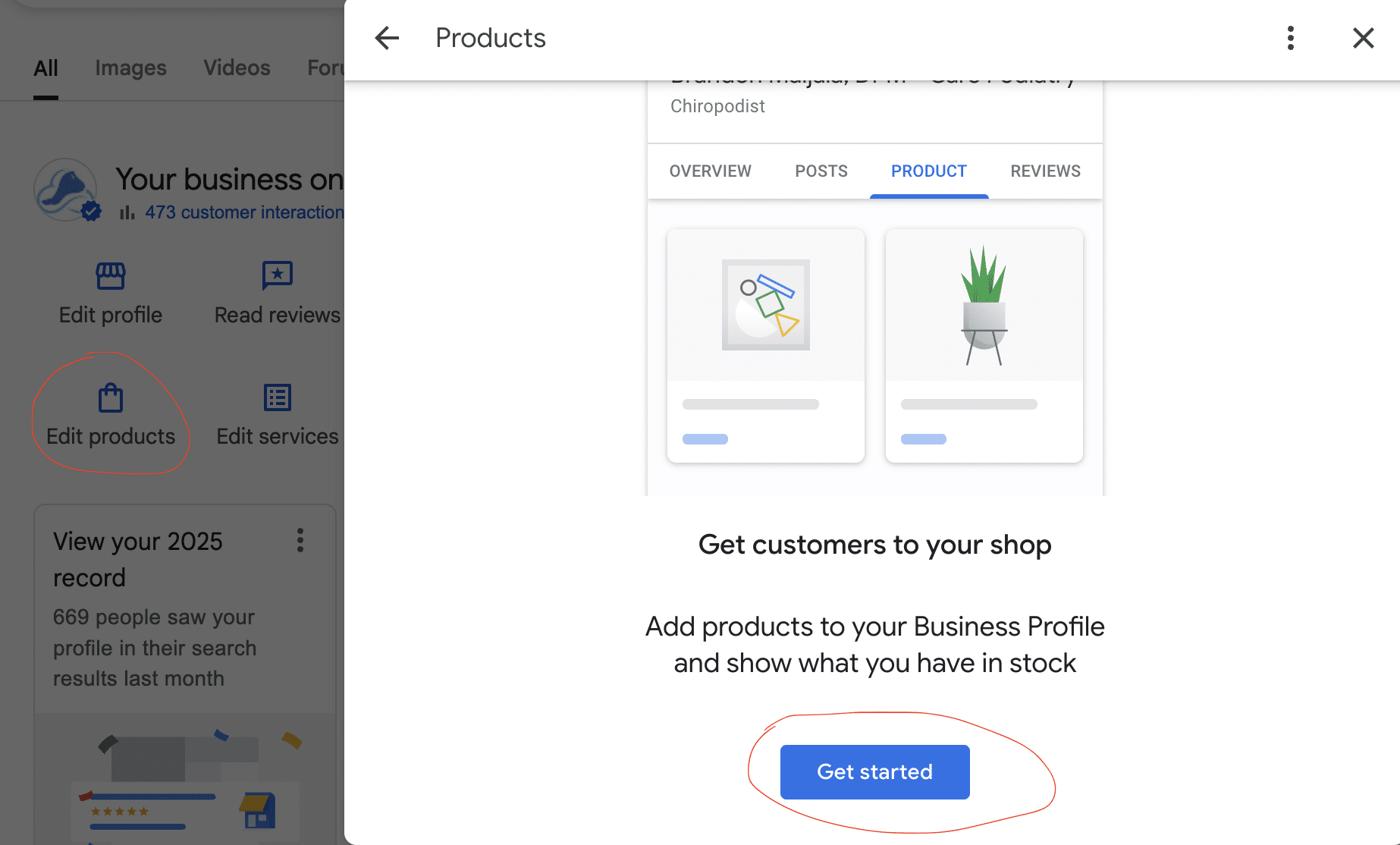
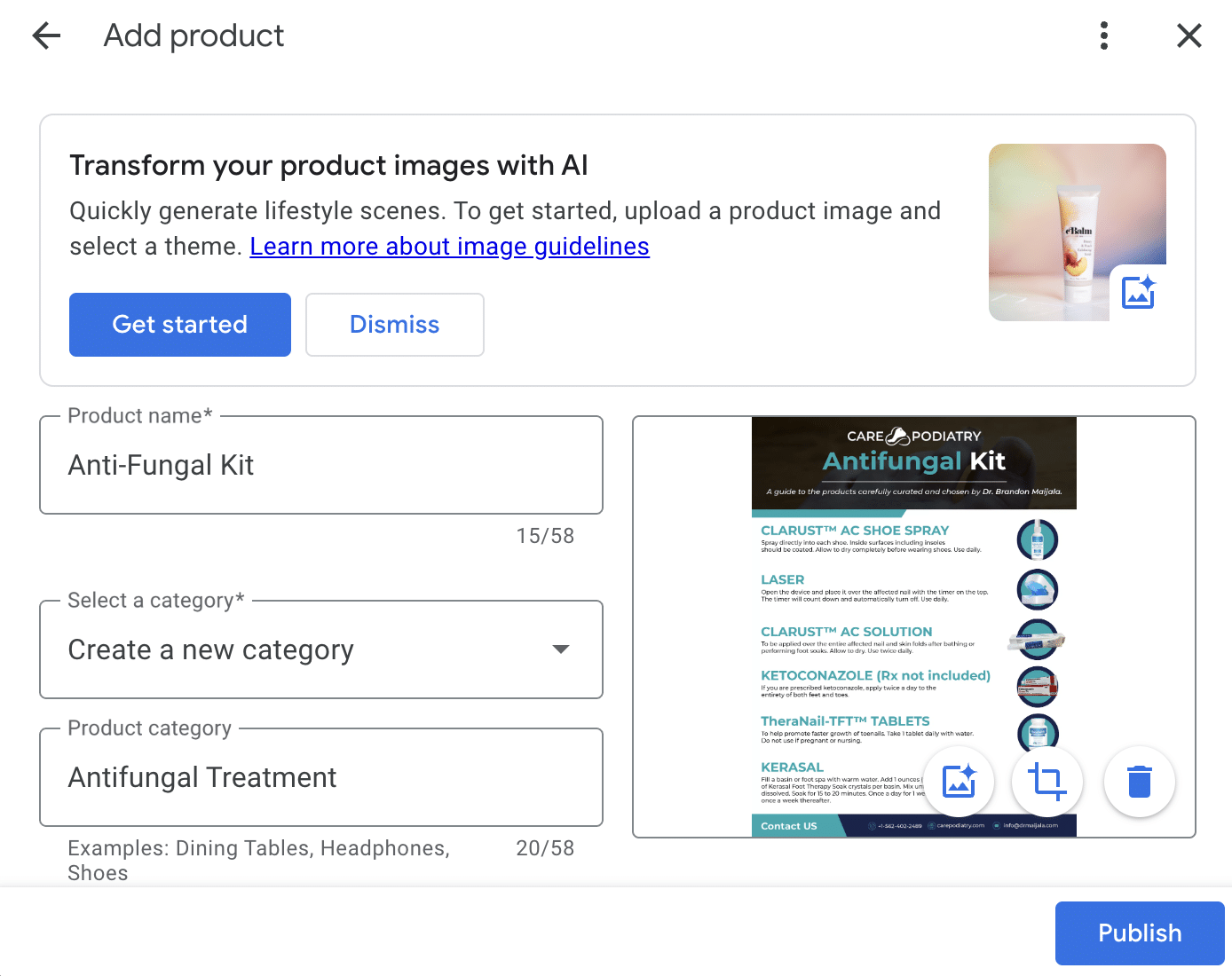
Why should you add these?
Tip from the experts: group items by condition (“Diabetic Foot-Care Kit,” “Post-Op Shoe,” “Sports Orthotics”) instead of generic names. Clear labeling improves click-through and legitimizes your expertise.
Implement these 3 features: smart categories, conversion-oriented attributes, and a curated product shelf; and you’ll strengthen the Google signals that account for local pack ranking factors.
Start with the problems patients actually type while wincing at 10 p.m; not marketing jargon. Pull your appointment logs and jot down every complaint you hear: bunion pain, ingrown-toenail swelling, heel-spur agony. Then validate that list with data: Ahrefs shows “podiatrist near me” draws roughly 83k U.S. searches a month: proof that location-intent sits at the top of the funnel.
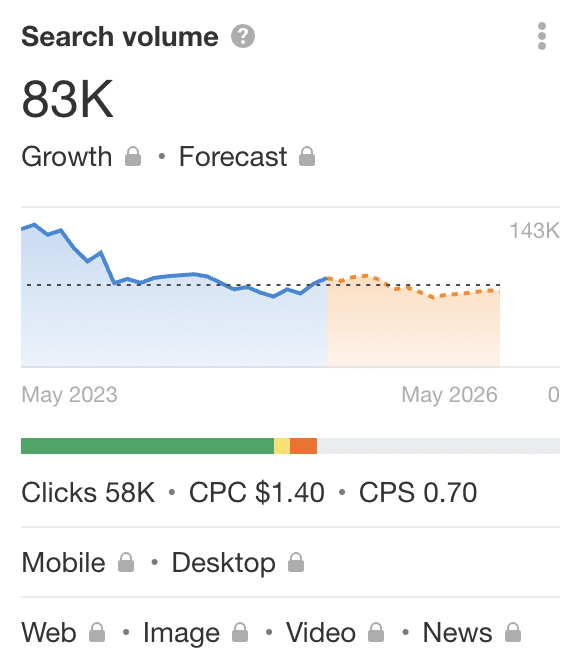
Here’s a snippet of one of our podiatrists ranking for the “podiatrist near me” keywords within one month of implementation. And the rankings are still consistent after 5 months:
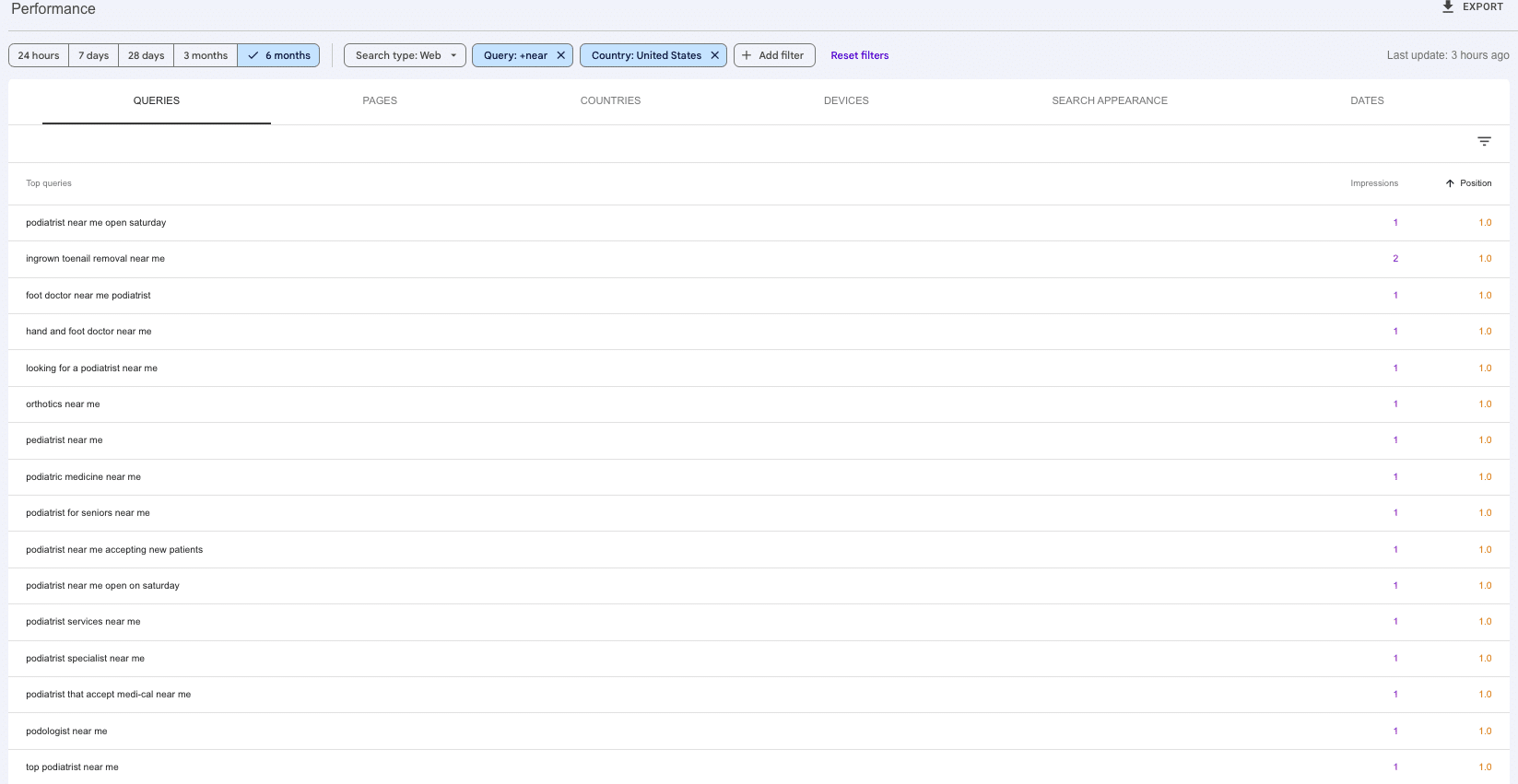
Semrush’s Keyword Overview tells a similar story further down the path to purchase: “best shoes for plantar fasciitis” pulls 27,100 monthly searches, a clear sign sufferers are hunting for specific solutions, not general foot care tips.
Prioritize seed terms that merge a pain point + treatment + locale, e.g., “bunion surgery Lake Worth” or “plantar fasciitis therapy Wellington” etc. These combinations are low-competition and mirror the language patients use when they finally decide to book an appointment.
Work through these sources once a quarter, and you’re getting a fresh seed list of keywords to target and refresh.
Let us do the marketing while you concentrate on your podiatry practice. Book a free strategy call with us.
If you’re still using generic pages like “/services” or “/locations,” you’re missing the mark (and even patients). Each service-city page should feel like it was written for a specific person searching in that specific place.
That starts with the URL: think /plantar-fasciitis-treatment-miami instead of something vague.
Use a title tag like: “Plantar Fasciitis Treatment in Miami | Dr. X Foot & Ankle Clinic”.
The meta description should match the searcher’s moment: “Heel pain slowing you down? Our Miami foot specialists offer expert plantar fasciitis care. Book now—walk pain-free again.”
Avoid keyword stuffing. Just be precise, local, and patient-focused. If you’re covering multiple services in one city, break them into individual pages. This isn’t just for SEO; it improves the user experience by letting potential patients feel like you understand their exact issue.

Service pages can’t just be a block of text and a phone number anymore. Visitors want proof. Add before-and-after photos for bunion correction or toenail restoration (with patient consent). If you offer financing for procedures not fully covered by insurance – say so. A clear breakdown of costs or a “Payment Plans Available” badge can ease hesitation.
Add testimonials, photos of your clinic exterior (yes, even the parking lot – it builds trust), and FAQ sections that address “Is this covered by insurance?” or “Does this treatment require downtime?”
This combination of clarity + local proof doesn’t just help you rank: it makes the phone ring.
Keeping your clinic’s Name, Address, and Phone (NAP) identical everywhere sounds trivial, yet it’s the single biggest trust-signal Google checks before letting you anywhere near the 3-pack.
When we audited more than 50 podiatry listings last quarter, one in four had a stray suite number or an old fax line floating around – each mismatch was enough to knock them out of map results for searches like “foot doctor near me.”
These things matter because 84% of patients read at least 3-4 online reviews before choosing a provider.
Core healthcare directories you can’t ignore for medical practices: Must-Have Listing Google Business Profile, Apple Maps & Bing Places, Healthgrades, Vitals & WebMD Care and ACFAS/APMA Finder. Let your marketing team know that you need listings for your practice from these health directories.
If you’re unsure whether listings already exist, here’s how to check for duplicates and remove them:
Steady NAP + clean citations equals a clear signal to Google.
Get an exclusive podiatry marketing plan for your practice. Book a free strategy call with us.
Automate asking for reviews if you’re sure it will be a one-time visit; and stay HIPAA-compliant.
“Our post-visit texts push happy patients straight to Google while funneling unhappy ones to a private survey. This keeps the feedback loop clean and the inbox calm.”
Read more about how we implemented a perfect feedback system, interviewed by RepuGen.
A steady inflow of fresh, five-star reviews tells Google and prospective patients that your podiatry team is consistently delivering relief.
A single slip that reveals Protected Health Information (PHI) can be expensive; one New Jersey clinic paid $30,000 after staff mentioned patient details while sparring with a Google critic (data by ChartRequest).
It’s always better to reply to both positive and negative reviews. Here’s an example of a dormant profile because they don’t respond to a negative review proactively.
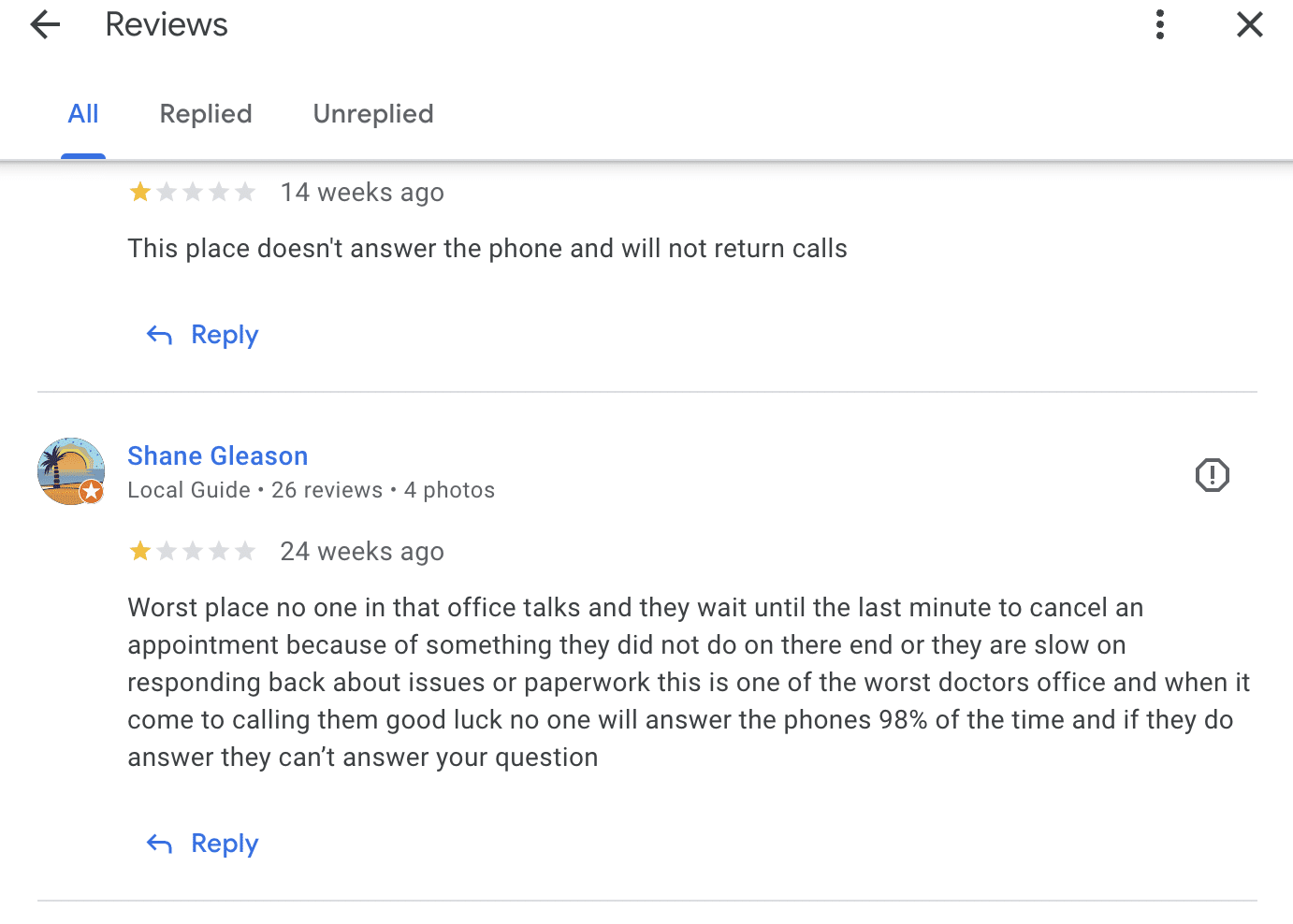
So. play it safe with this five-part script (edit as needed):
“Thank you for sharing your concerns. We’re committed to great foot care and would like to learn more. Please call us at [office number] and ask for our practice manager so we can help.”
Why it works:
If handled well, a calm, PHI-free response often impresses other readers more than the original complaint, turning a potential ranking drag into a trust builder.
Google’s official guidelines show that local links sit just behind reviews when it comes to climbing the Map Pack. In plain terms, a few well-placed community backlinks can move a podiatry clinic faster than another round of keyword tweaks. Let’s look at how we can achieve this.
One of the easiest wins is a reciprocal referral page with the physical-therapy groups that already send you post-op ankle and plantar-fasciitis cases. Write a short, experience-based intro for each other and publish those blurbs on dedicated “Trusted Partners” pages on both sites.
Because each page carries real-world intent (patients can click straight through to book), the link passes authority and traffic in equal measure.
You can also add a simple intake form or a Calendly widget so therapists can hand off patients; a great cross-referral program for both.
This is just one of the many possibilities for podiatry partnerships. The opportunities are endless, if done right.
Community events are link gold when you choose them carefully. A single charity 5K or high-school track meet usually includes a sponsors page, a results page, and a pre-race press release. That’s 3 separate backlinks for one modest fee. But before you sign the cheque, look at the organiser’s domain in Ahrefs or Moz; anything north of DR 30 is worth a conversation.
Once the link is live, repurpose the moment: post a “Runner’s Foot-Care Checklist” on your blog, share race-day photos on social media, and ask the organisers to drop that checklist into their registration emails. You’ll pick up extra branded links, referral traffic, and local awareness in a single shot.
The most important thing is to measure these clicks in Google Analytics. These collaborations rarely feel abstract.
For example, one of our podiatry clients is an official sponsor for the Baltimore Orioles (official baseball team from Baltimore) and it worked really well for him in terms of branding and backlinks.

When links come from relationships, not random directories, they signal two things that matter to both algorithms and humans: expertise in foot health and an active stake in the neighbourhood you serve.
For medical websites, implementing FAQ and Medical schema markup is a great addon. It’s a chance to claim more real estate in search results and present trust signals before anyone even clicks through.
Start by identifying the questions patients most often ask: “What causes plantar fasciitis pain in the morning?” or “How long does toenail fungus treatment take?”
Add those Q&As in the FAQ page JSON-LD and embed the script directly in your page’s header. That simple addition can unlock rich results like expandable answer snippets, giving your practice a jump on competitors who still rely on plain HTML.
For deeper context, add the MedicalEntity types defined by schema.org.
Search engines love this level of granularity – and it shows up in the results as fact-checked badges or “Learn more” links under your listing.
By combining FAQs and medical structured data, you’re signaling two things at once: that you understand the patient journey and that you meet Google’s criteria for expertise, authority, and trustworthiness in health content.
Symptom-focused searches represent some of the highest-intent moments in healthcare: when someone types “sharp heel pain when walking,” they’re looking for answers now. To capture that traffic, create standalone symptom pages or dedicated sections within service pages and mark them up with schema.
Once indexed, these symptom-specific snippets can appear as “rich cards” in mobile feeds or as “People also ask” entries on desktop.
Even better, if you couple symptom schema with a small FAQ (“How soon should I rest after heel pain starts?”), there’s double chances of appearing on two separate rich-result formats on the same SERP.
Every click, call, and booking reveals how patients discover and engage with your practice. Monitor website sessions, organic impressions, and CTR. Also measure appointment related actions like form submissions, call-tracking, and scheduling etc to balance visibility with conversions.
Bring it all into a live dashboard (Looker Studio) that blends Analytics, Ads, and phone data. This is where you can spot trends with the help of your marketing team like calls increases or dips, traffic surges etc to know if there’s seasonality in the entire patient acquisition journey. From these data points, you should have a clear, data-driven roadmap for growing your clinic.
Share:
Download FREE Podiatry Marketing Plan Template